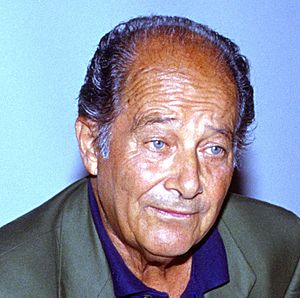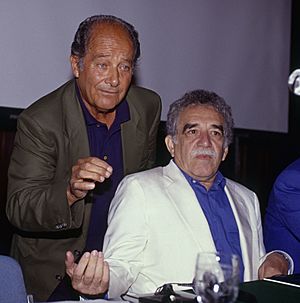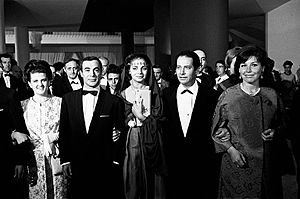Gillo Pontecorvo facts for kids
Quick facts for kids
Gillo Pontecorvo
|
|
|---|---|
 |
|
| Born |
Gilberto Pontecorvo
19 November 1919 Pisa, Italy
|
| Died | 12 October 2006 (aged 86) Rome, Italy
|
| Occupation | Film director, screenwriter, composer |
| Years active | 1953–2003 |
|
Notable work
|
|
| Spouse(s) | Maria Adele "Picci" Ziino (m. 1964) |
| Children | Marco Pontecorvo |
| Relatives | Bruno Pontecorvo (brother) Guido Pontecorvo (brother) |
Gilberto "Gillo" Pontecorvo (19 November 1919 – 12 October 2006) was an Italian film director. He was known for making "political cinema" in the 1960s and 1970s. This type of film often explored important social and political issues.
He is most famous for directing The Battle of Algiers (1966). This film was a docudrama, meaning it mixed documentary style with drama. It won the top prize, the Golden Lion, at the 21st Venice International Film Festival. Pontecorvo was also nominated for two Oscars for this film. He was nominated for Best Director and Best Original Screenplay.
His other important films include Kapò (1960), which was about the Holocaust. He also directed Burn! (1969), a historical film about a slave revolt. Another film, Ogro (1979), showed the assassination of a Spanish prime minister. He also made many shorter films and documentaries.
In 2000, he received the Pietro Bianchi Award at the Venice Film Festival. In the same year, he was given a high honor, becoming a Knight's Grand Cross of the Order of Merit of the Italian Republic.
Contents
Early life and political involvement
Gillo Pontecorvo was born in Pisa, Italy. His family was wealthy and Italian Jewish. His father was a businessman. Gillo had several siblings, including his brothers Bruno Pontecorvo and Guido Pontecorvo. Bruno became a famous nuclear physicist. Guido was a geneticist.
Gillo studied chemistry at the University of Pisa. However, he left before finishing his degree. At the university, he first learned about different political ideas. He met students and professors who had leftist views. In 1938, because of growing antisemitism (prejudice against Jewish people), he moved to Paris. There, he worked as a journalist and a tennis teacher.
In Paris, Pontecorvo became interested in filmmaking. He started by making short documentaries. He worked as an assistant to Joris Ivens, a Dutch documentary filmmaker. He also assisted Yves Allégret, a French director. Pontecorvo met many famous people in Paris, like artist Pablo Picasso and composer Igor Stravinsky. These meetings helped him develop his own political beliefs. He was deeply affected when many friends went to fight in the Spanish Civil War.
In 1941, Pontecorvo joined the Italian Communist Party. He went to northern Italy to help organize Anti-Fascist groups. Using the name Barnaba, he became a leader in the Italian resistance movement in Milan. This was from 1943 to 1945. He also helped edit a communist magazine called Pattuglia. In 1956, he left the Communist party. This was after the Soviet Union used force to stop an uprising in Hungary. However, he still believed in Marxism, which is a way of understanding society and economics.
In a 1983 interview, Pontecorvo said he was not a full revolutionary. He described himself as "a man of the Left," like many Italian Jews.
Film career highlights
After World War II, Pontecorvo returned to Italy. He decided to leave journalism and focus on filmmaking. He was inspired after seeing Roberto Rossellini's film Paisà (1946). He bought a camera and started making documentaries. His first was Missione Timiriazev in 1953. He also directed a part of the film La rosa dei venti (1957).
In 1957, he directed his first full-length film, La grande strada azzurra (The Wide Blue Road). This film showed his future style. It was about a fisherman and his family on an island. The fisherman had to fish illegally to survive. The film won an award at the Karlovy Vary International Film Festival. Pontecorvo often spent months researching his films. This helped him show social situations accurately. In 1960, he directed Kapò, a drama set in a Nazi death camp. It was about a young Jewish girl trying to escape. In 1961, it was nominated for an Oscar for Best Foreign-Language Film.
The Battle of Algiers: A famous film
Pontecorvo is most famous for his 1966 film The Battle of Algiers. Many people consider it one of the best films of its kind. It is a neorealistic film. It shows the Algerian resistance during the Algerian War. Pontecorvo used a style like newsreels and used non-professional actors. He focused on the native Algerians, who were not often shown in media.
The film was co-produced with an Algerian film company. The script was written so that real Front de Libération Nationale (FLN) leaders could act in it. For example, the character Djafar was played by an FLN leader, Yacef Saadi. Pontecorvo's film was clearly against imperialism (when one country controls another). He said the film was a "hymn" to people fighting for independence. He believed that "the birth of a nation happens with pain on both sides."
The Battle of Algiers was very successful and influential. It was shown widely in the United States. Pontecorvo received many awards for it. The film has even been used as a training video. It was used by revolutionary groups and by military governments dealing with resistance. It is still very popular in Algeria. It helps people remember their fight for independence from France.
The film's style, using a semi-documentary approach and mostly non-professional actors, influenced many filmmakers. Its impact can be seen in later films.
Later works and festival role

Pontecorvo's next big film was Queimada! (Burn!, 1969). This film was about a fictional slave revolt in the Lesser Antilles. It starred Marlon Brando. Pontecorvo continued making political films with Ogro (1979). This film was about Basque terrorism in Spain. He kept making short films into the early 1990s. He also directed a follow-up documentary to The Battle of Algiers called Ritorno ad Algeri (Return to Algiers, 1992).
In 1992, Pontecorvo became the director of the Venice Film Festival. He was in charge of the festivals in 1992, 1993, and 1994. In 1991, he was also a judge at the 41st Berlin International Film Festival.
In a 1991 interview, Pontecorvo was asked why he had directed so few movies. He said he could only make a movie if he truly loved the project. He also mentioned that he had turned down many other film offers.
Death
Gillo Pontecorvo passed away in 2006 in Rome. He was 86 years old. He died from congestive heart failure.
Filmography
Feature films
| Title | Year | Functioned as | Notes | ||
|---|---|---|---|---|---|
| Director | Writer | Composer | |||
| The Wide Blue Road (La grande strada azzurra) | 1957 | Yes | Yes | No | Nominated - Crystal Globe (Karlovy Vary International Film Festival) |
| Kapo (Kapò) | 1960 | Yes | Yes | Yes | Nominated - Great Jury Prize (Mar del Plata International Film Festival) |
| The Battle of Algiers (La Battaglia di Algeri) | 1966 | Yes | Yes | Yes | Golden Lion (Venice Film Festival) Nastro d'Argento for Best Director Nominated - Academy Award for Best Director Nominated - Academy Award for Best Original Screenplay Nominated - Nastro d'Argento for Best Score |
| Burn! (Queimada) | 1969 | Yes | Story | No | David di Donatello for Best Director |
| Ogro (Operación Ogro) | 1979 | Yes | Yes | No | |
Documentary films
| Title | Year | Functioned as | Notes | ||
|---|---|---|---|---|---|
| Director | Writer | Composer | |||
| Missione Timiriazev | 1953 | Yes | No | No | |
| Porta Portese | 1954 | Yes | No | No | |
| Festa a Castelluccio | 1954 | Yes | No | No | |
| Uomini del marmo | 1955 | Yes | No | No | |
| Cani dietro le sbarre | 1955 | Yes | No | No | |
| Pane e zolfo | 1959 | Yes | No | No | |
| Gli uomini del lago | 1959 | Yes | No | No | |
| Paras | 1963 | Yes | No | No | |
| Addio a Enrico Berliguer | 1984 | Yes | No | No | |
| Un altro mondo è possibile | 2001 | Yes | No | No | |
| Firenze, il nostro domani | 2003 | Yes | No | No | |
Short films
- Giovanna (1957, segment of Die Windrose)
- Udine (1984, segment of 12 registi per 12 città)
- Gillo Pontecorvo's Return to Algiers (1992)
- Danza della fata confetto (1996)
- Nostalgia di protezione (1997)
See also
 In Spanish: Gillo Pontecorvo para niños
In Spanish: Gillo Pontecorvo para niños


